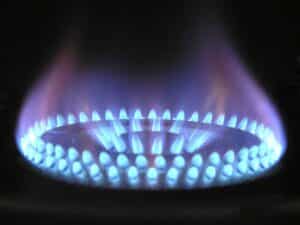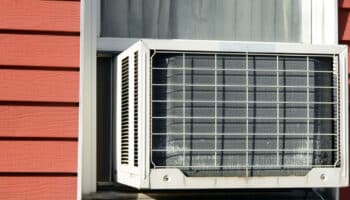We've independently reviewed this article to make sure it's as accurate as we can make it.
To find out more about our article creation and review process, check out our editorial guidelines.
If you’re looking into heating or cooling systems, then BTU’s are a must-know to get the best bang for your buck.
As an engineer I often get asked about these strange units. So I’ve put together this easy guide to help anyone understand them. In short:
‘BTU’ stands for British Thermal Units. It’s how we measure heating and cooling. One BTU is the amount of energy to raise the temperature of 1 pound of water by 1 degree Fahrenheit. BTU ratings are common in both heating and air conditioning: the term has been used since the 1800’s.
To give an idea, one wooden match produces about one BTU of heat.
Interested in finding out more? Then let’s dive into the details.
What does BTU mean?
You may be surprised to find out that 1 BTU isn’t the amount to heat 1 British cup of tea!
BTU is a 200-year old acronym: BTU stands for British Thermal Units: a measurement of thermal energy. This is the energy we need to heat (or cool) one pound of water by 1 degree Fahrenheit.
BTU’s tells you how much heating or cooling an appliance can give you – and what size of room it can heat.
The bigger your room, the more BTU you need.
Where are British Thermal Units used?
These units are used mostly in manufacturing and home appliances. Including:
- Air Conditioning
- Heating
- Fuel (Propane Appliances)
- Cooking
- Steam Power
Is Higher or Lower BTU Better?
With a unit related to power, this can sometimes be tricky for people to wrap their head around.
A higher BTU means more heating or cooling power. So for a larger room, you need more power to cool or heat it.
At the same time, too much power can be inefficient. Your room may get way too hot or cold very quickly. It’s important to know how many BTU’s you need to get the most efficient and comfortable heating/cooling system for your space.
How many BTU’s do I need?
This is the big question.
Getting an approximate BTU requirement isn’t too hard, but you need to make sure you’re accurate. For example, too large of an air conditioner can lead to mold issues – because it cools too fast without being able to remove moisture from the air.
That being said, we can give some ball park estimates using typical sizes and calculators below. Use this to give yourself an idea, but you do really want a professional to run a detailed calculation before you buy a system costing thousands of dollars!
Air Conditioning
Getting the right amount of cooling power from an air conditioner is where you need to know BTU. And boy is it everywhere.
There’s more ratings than the oscars: and it’s not easy to know how much you need.
Thankfully, everything is fairly standardized these days.
This table gives a quick overview of recommended air conditioning BTU’s by room size.

However, that’s a little too simple.
There’s a few other factors to consider in the amount of BTU you need. I’ve covered them in the ‘BTU Factors’ section below.
Free BTU Calculator
I’ve put together a quick calculator for single room air conditioners (window/portable/mini-splits).
Just put in your details, and it’ll give you a rough estimate of the BTU you need!
Bear in mind this is only a rough BTU estimate. You should consult a local contractor/technician to confirm it.
Heating
Likewise, space heaters also have standard measurements we can use. These are much simpler than in air conditioners and are more based on Watts than BTU. In short, all we need to do is times the square foot of your space by 10.
So a 150 sq. ft room would simply need a 1500 Watt heater.
This is a much easier rule of thumb than using BTU, with 3.41 BTU’s equal to 1 Watt.
BTU Factors
Not every home is the same.
Sure, we can both have 20′ x 20′ space. But if mine is an uninsulated garage, and yours is an insulated living room, we’re going to need different levels of heating or cooling!
Here are some major factors you should consider for the BTU you need for your space. In addition to room size, think about:
- Your Climate. The thing to understand about air conditioners is that they operate relative to the outside temperature. An AC doesn’t just ‘get’ the coolness you want – it’s battling against the outdoor temperature. So the hotter it is outside, the more power (in BTU) your unit needs to fight against that. In short – hotter climates demand higher BTU ratings.
- Room Height. Area isn’t everything. The taller a room, the more volume you need to cool. If your ceilings are extra tall (above 8 feet), then add around 10% more BTU to your requirement.
- Direct Sunlight / Shade. If you’re looking to cool a room that’s right in the sun, you’ll need another 10% boost to your BTU. Make sure to keep your curtains closed to block any direct sunlight on a hot day. If it’s mostly in the shade, you can take 10% off instead, but do it conservatively.
- Insulation. These next few points all relate to how quickly you lose heat. Insulation is the #1 factor for heating/cooling efficiency. If you have bad insulation, don’t add anything to the power you need. Instead, add to your insulation! Insulation will always get you the biggest return on the dollar.
- Windows. Windows naturally let heat out/in more than a wall. Large windows may need a power boost – especially if they’re drafty and not double glazed.
- Outside Walls. Quite self explanatory here – if you’ve got exterior walls in the room, you’ll be dealing with more outside temperature input.
- Occupancy. People produce heat, and this definitely contributes to the heating/cooling you need. Not only from our bodies, but from the electronics we’re always using these days, too. If the room is usually occupied by more than 2 people, we recommend adding around 600BTU per extra person.
- Kitchen. Trying to keep a kitchen cool while cooking is a monumental task. If you want to battle the heat, I’d add an extra 4,000 BTU to your cooling requirement. The good news is you can always buy a powerful unit and run it on low when you’re not cooking up a storm.
Now, not to make you overthink this, but you can get too many BTU’s as well!
- A super powered air conditioner will have your room cool so quickly that it’ll need to turn itself off. This can mean it’s always switching on and off quickly, resulting in a lot of noise and energy use.
- All that switching on and off can wear down the compressor quicker than normal, too.
- Rapid cooling can mean that the units dehumidifier doesn’t have time to remove moisture from the air. That can mean you get a cool room that’s still humid! Let me tell you, no-one enjoys being that clammy.
If you want extra power, try to go for a max of 2,000 BTU about what you would normally need to avoid these.
Why do we use British Thermal Units (BTU)?
British Thermal Units are so widely used simply because they were the first definition of this type. The first to put a label on the amount of heat (or cooling) in terms of energy.
Not only do they allow us to rate different models of air cons / heaters, they also allow us to compare different types of fuel, too.
As they were the first unit to be used in the description of heating/cooling, BTU’s have become a standard unit in many countries. Like a mile, or a watt. Despite their funny name, they’re used in so many different industries – from HVAC to Aviation. They won’t be going anywhere soon.
Despite being an imperial unit (based on Fahrenheit and lbs) they are even used in some metric countries! The metric equivalent is actually calories, but BTU use is so widespread for appliances – often built or made for the USA – that this unit is used instead.
Calories? Really?
Yes! Although we often use them for food, the definition of a calorie is:
“Calorie: The energy needed to raise the temperature of 1 gram of water through 1 degree celsius.”
Bear in mind that both BTU and Calorie is measured in energy. This ‘energy’ is what we use to measure foods – how many units of energy a food contains.
I know what you’re thinking..
Yes, you could use BTU’s to measure your food. Imagine freaking people out by dieting in British Thermal Units!
If you want to convert them – 1 BTU is equal to around 0.252 nutritional calories. Just imagine:
Bob: Hey Jill! How’s your diet going?
Jill: It’s going great thanks Bob! I had 2,000 British Thermal Units for lunch!
Bob: Jill… are you okay?
What Fuel Has The Most BTU per Dollar?
One of the most useful aspects of thermal units – as well as comparing heating/cooling units – is comparing types of fuel.
By knowing how much energy is stored in a type of fuel, we can see how effective they are at heating us. And combined with the per dollar cost, what will give us the best bang for our buck.
Below are BTU’s per fuel according to the Energy Information Administration, and their latest prices according to my best Google-fu.
| Energy Source | Unit | BTU | Cost ($) | BTU per $ |
| Electricity | 1 KWh | 3,412 | 0.12 | 28,433 |
| Motor gasoline | 1 Gallon | 120,333 | 2.5 | 48,133 |
| Diesel fuel | 1 Gallon | 137,381 | 2.9 | 47,373 |
| Heating oil | 1 Gallon | 138,500 | 3 | 46,167 |
| Propane | 1 Gallon | 91,333 | 2.4 | 38,055 |
Did you know? The USA used around 7.5 billion barrels of petrol last year. That’s 36.95 quadrillion BTU! Or 3,695,000,000,000,000,000,000,000 BTU. That’s quite a lot of energy.
What’s the History of BTUs?
First coined in the late 1800’s, a BTU is a measurement used throughout the world today.
Originally used for Steam Engine design, it was mentioned in an 1885 book on ‘Steam Engines’ by Scottish Engineer William Rankine. 12 years later, in 1897, the full name of ‘British Thermal Unit’ was being used by Engineers of different disciplines.
While any modern-day contractor will have a calculator to work out the amount of heat you need today – these didn’t arrive until British Thermal Units did. Before then, engineers would simply use rules of thumb in figuring out how much heat is required to heat a room/building. As an example dating back to 1883, Baldwin
“Writing in 1883, Baldwin describes heating calculations as: The ordinary rule of thumb way of the average pipe fitter, is to multiply the length by the width of a room, and the result by the height, then cut off two figures, from the right hand side, and call the remainder square feet of heating surface, with an addition of from 15 to 30 per cent for exposed or corner rooms.”
Not quite the same as typing some numbers into a computer!
Since their conception, British Thermal Units have proven to be a reliable way to measure heating/cooling power – and are essential in all HVAC disciplines today.
Are British Thermal Units really British?
Sort of.. but not really.
One thing to understand about these units is they were ‘invented’ by British Engineers. But back in the 1800’s, the British were the only English-speaking engineers to really be inventing anything. So I’m not entirely sure why they were given that name if everything else from the 19th century wasn’t. But whatever the case, it’s stuck.
Interestingly, Britain also uses ‘BTU’ on their air conditioner ratings. I would’ve thought it would only be ‘Thermal Units’!
Other Uses for BTU
As well as HVAC appliances, there are plenty of other systems which use BTU as ratings. Including…
Gas Stoves / Ranges

Our trusty old gas ranges have almost always been rated in BTU’s. These can range anywhere from a few hundred to the average of 8,000, all the way to over 18,000 BTU worth of power.
That said, not having insane amounts of BTU in your kitchen isn’t a bad thing. Often super stoves are too powerful, and become impossible to cook with. There’s a lot to be said for the humble home stove!
Note: While gas stoves tend to be measured in BTU’s, electric ranges are typically measured in watts – just like heaters.
Solar Power

With solar panels often being used as supplemental power for heaters or air conditioners, British Thermal Units are important here, too.
By knowing how many watts a solar panel can give you (typically around 300 watts per hour) you can estimate your savings from running your HVAC system partly via your solar panels.
Energy Comparisons

While BTU can be used as a heating efficiency measurement, it can also be used as an energy efficiency rating, too. It’s very possible to put a dollar cost on the number of BTU’s you get from an energy source – and British Thermal Units are often used as a key comparison between electricity and natural gas, in particular.
Conclusion
When you’re shopping for certain types of appliances, British Thermal Units are everywhere.
Understanding what BTU means is key to getting the right size of unit to heat or cool your home. I hope this quick guide has helped unveil the mysterious of these strange units.
If you’re in the market for a one-room air conditioner or heater, be sure to check out our related articles. We specialize in understanding and reviewing units for just that kind of purpose!
I hope this content has helped you out. We write entirely for free, and are only supported by our readership. Please consider supporting us by checking out some of our related articles!
Thank you for reading, and have a great day 🙂
-Craig







